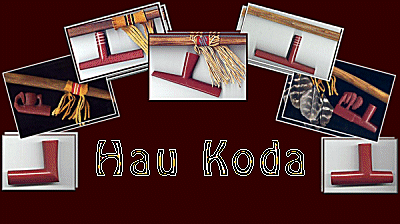
|
The Gift of the White Buffalo Calf Woman - The Pipe The Lakota have a legend which says that a beautiful woman dressed in white buckskins bought them a gift to be used in ceremony, it was a pipe made out of red stone and highly decorated. She stayed with them for a while and taught them the seven sacred rites or ceremonies. In all of them the Pipe or Chanupa plays an integral role. The Rites were the Wiwanyag Wachipi, the Inipi, Hanblecheyapi, Hunkapi, Ishna Ta Awi Cha Lowan , Tapa Wanka Yap and the Keeping / Releasing of the Spirit (Black Elk says soul). Some say that the White Buffalo Calf Woman also told the People where to find the sacred red stone to make the Pipes from, and that of course was the Great Pipestone Quarries in southwestern Minnesota. She also stated that 'The bowl of this Pipe is of red stone; it is the earth. The stem of the Pipe is of wood, and that represents all that grows upon the earth.' 'All of the things of the universe are joined with you who smoke the pipe - all send their voices to Wakan Tanka, the Great Spirit. When you pray with this Pipe, you pray for and with everything.' Over the years the pipe has become known as the 'Peace Pipe', although this is not strictly correct as it has been used for various ceremonial uses, sometimes even for waging war. Some Native people also smoke the pipe in a social way, without ceremony or structure. Many years ago the tradition of having a pipe almost died when the U.S. Government dictated that ceremonies such as the Sundance were prohibited. In all ceremonies the pipe plays a large role, so that with the illegality should have come the loss of the pipe. However many ceremonies went underground on reservations, the People themselves smoked their pipes in their homes, or hid them away until it was safe to bring them out in the open. For most of this time the quarries at Pipestone were still used by a few Native People and so the art of quarrying was passed on through the generations. These same people kept the pipe alive through a period of darkness until in the 1970's the Sundance was once more allowed to be performed. The Pipe was ready to be brought out into the light again. The Dakota people who resided in Pipestone once more took up quarrying the beautiful red stone for the People, the quarriers had not lost the art as it had been handed down through the families. The three families who had been keeping the Quarries open and safe were the Derby's, The Taylor's and the Bryan's. It is thanks to these people that the pipe was able to survive. Had they not have perpetuated the quarrying process the stone would have been lost. No stone, no Pipe. The Native American People owe a great deal to these few people. Stone was still available to make their pipes for ceremony.
The Native American People here, including those same three families, still quarry the stone, and make the Pipes in a very reverent way. They know that one must not say anything negative around the quarry area, one has to always think good thoughts, pray, and leave offerings for the Spirits residing in the area. Many of the Pipe-makers are fourth generation craftspeople, who have learned the right way to make Pipes from their fathers and grandfathers. They know the right way and would do nothing to be sacrilegious towards either the stone, the quarry area, or the Pipes. Many Traditionals believe that a Pipe stem should not be joined to the bowl, unless you are about to smoke it. The Pipestone craftspeople agree with that, but only after the Pipe has been consecrated by smoking it. Prior to that it is like a child in it's mother's womb, waiting to be born. Each piece of the Pipe is made for the other at the same time. If they are parted before birth it is like a child losing a limb. You, the person who ends up with the Pipe, become the parent. You put the final touch to it, which is your love and respect. When you smoke a Pipe you should be sending prayers to Wakan Tanka via the smoke. So please, please, please, do not even think of using any substance in it which could cause disrespect to the Creator or yourself. The tobacco used in a Pipe is not halucinary in any way. Drugs are never used by Native Americans in their Pipes.
IMPORTANT Please take care of your Sacred Pipe, it is the life and soul of many Native American Cultures. Do not leave it on display once you have used it. It is an altar at that point, and each section should be wrapped separately, (preferably in red cloth) and stored away from prying eyes and hands.
This site is constructed by Dragonfly Dezignz a proud member of the following organizations:
Copyright
of this site is by Dragonfly-Dezignz 1997 - 2003 All Rights Reserved. |

 PAGE
2
PAGE
2





